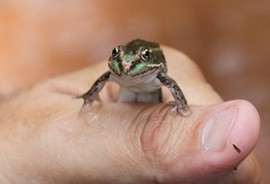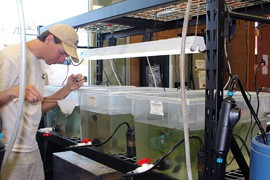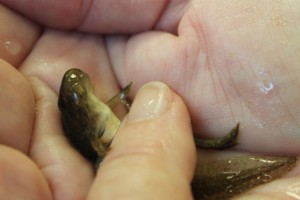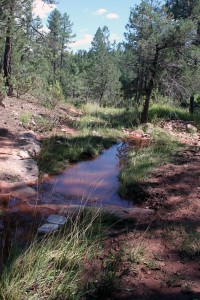- Slug: BC-CNS-Chiricahua Frog,525
- Sidebar Below: Facts about Chiricahua leopard frog
- Photos available (thumbnails, captions below)
By JENNIFER GAIE HELLUM
Cronkite News Service
STAR VALLEY – Under the shade of soaring Ponderosa pines, a young frog wriggles free from a man’s hand and swims across a muddy pool.
“There he goes – number 10,000,” says Mike Sredl, who coordinates the Arizona Game and Fish Department’s effort to restore the Chiricahua leopard frog.
Earlier in the day, this frog and 1,500 other frogs and tadpoles were in tanks at the Phoenix Zoo’s Conservation Center. By day’s end, they occupied pools at four locations in the Tonto National Forest.
The release brought to 10,000 the number of Chiricahua leopard frogs that have been released into the creature’s native range in Rim Country and the White Mountains.
“It’s really the culmination of what we do in terms of conservation,” said Bert Castro, president and CEO of the Phoenix Zoo.
Drought, habitat destruction, disease and competition from non-native bullfrogs, crawfish and salamanders combined to push the species toward extinction. In 2002, the U.S. Fish and Wildlife Service listed the Chiricahua leopard frog as threatened.
Since 1995, Game and Fish, the Phoenix Zoo and federal agencies have collaborated to recover egg masses from the wild and raise the frogs in a lab.
Sandy Bahr, director of the Sierra Club’s Grand Canyon Chapter, said another measure of the program’s success is the fact that one of the group’s volunteers recently found a Chiricahua leopard frog in the White Mountains.
“Perhaps frogs don’t get as much attention as some of the furrier creatures, but they really are the canaries in the coal mine,” Bahr said in a telephone interview. “They tell us what’s going in our environment. They’re critical to our ecosystem health.”
Noah Greenwald, endangered species director for the Tucson-based Center for Biological Diversity, called the milestone a positive sign. His group petitioned the federal government in 1998 to protect the Chiricahua leopard frog under the Endangered Species Act.
“It shows that getting a species added to the list really does lead to action,” Greenwald said.
The partnership’s latest effort to boost the population began last spring with the recovery of two egg masses of roughly 2,200 eggs near the remote community of Young.
At the zoo’s conservation center, technicians maintained conditions maximizing the chances that the eggs would hatch and that tadpoles and frogs would be disease-free and ready to release four months later.
Sredl, ranid frog project coordinator for Game and Fish, said raising frogs in captivity dramatically increases their chances of surviving.
“In the wild, the estimated number of eggs in an egg mass that survive from an egg to a reproductive individual is about 5 percent,” he said. “In the captive situation in the zoo, the number increases to 60 percent.”
“The one variable that they don’t have in captivity is someone trying to eat them all the time,” said Stuart Wells, the zoo’s director of conservation and science.
Frog No. 10,000 and its companions rode to Rim Country in coolers containing ice packs. Several people applauded as the frog latched on to a moss-covered rock next to water trickling from an overhang.
“Look at that waterfall,” Sredl said, assuming the frog’s reaction. “They didn’t have that at the zoo.”
^___=
Web Links:
_ Arizona Game and Fish Department: www.azgfd.gov
_ Phoenix Zoo: www.phoenixzoo.org
_ Center for Biological Diversity (long link; can be added to story body)
^___=
Key facts about the Chiricahua leopard frog
Here are some key facts about the Chiricahua leopard frog:
– Scientific name: Rana chiricahuensis
– Status: Listed as threatened since 2002.
– Reasons for decline: Disease, habitat loss, competition from non-native species and drought.
– Description: Spotted, greenish with a raised fold of skin running down each side of its back. Grows from 2 to 5 inches in length.
– Habitat: Historically found in bodies of water and livestock tanks at higher elevations in central, east-central, and southeastern Arizona, in west-central and southwestern New Mexico and in parts of Mexico.
Source: U.S. Fish and Wildlife Service
^___=
A young Chiricahua leopard frog readies itself for release into a pool in the Tonto National Forest near Star Valley on Monday, August 23, 2010. Biologists raised the threatened animals in captivity as part of a program that recently released its 10,000th frog into the wild. (Cronkite News Service Photo by Jennifer Gaie Hellum)
Intern Luke McRoberts counts tadpoles at the Phoenix Zoo Conservation Center lab on Monday, August 23, 2010. The center raises Chiricahua leopard frogs as part of a state effort to restore the threatened species to the Mogollon Rim and White Mountains. (Cronkite News Service Photo by Jennifer Gaie Hellum)
A Chiricahua leopard frog tadpole receives a developmental assessment at the Phoenix Zoo Conservation Center lab Monday, August 23, 2010. Biologists raise the threatened animals in captivity as part of a recovery-and-release program that recently released its 10,000th frog into the wild. (Cronkite News Service Photo by Jennifer Gaie Hellum)
Containers of Chiricahua leopard frogs sit a pool in the Tonto National Forest near Payson on Monday, August 23, 2010. Biologists raised the threatened animals in captivity as part of a recovery-and-release program that recently released its 10,000th frog into the wild. (Cronkite News Service Photo by Jennifer Gaie Hellum)



